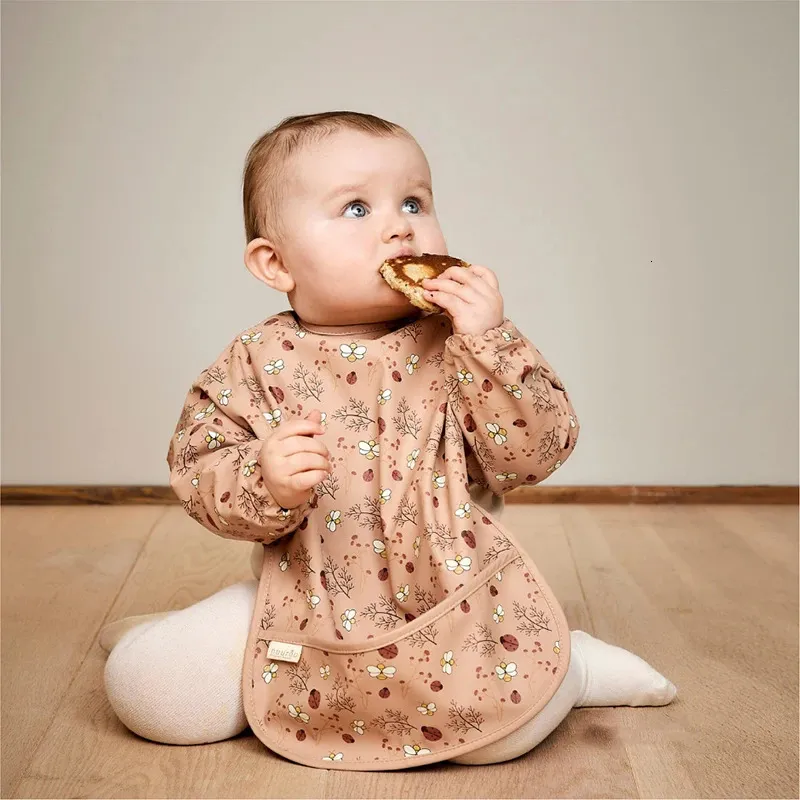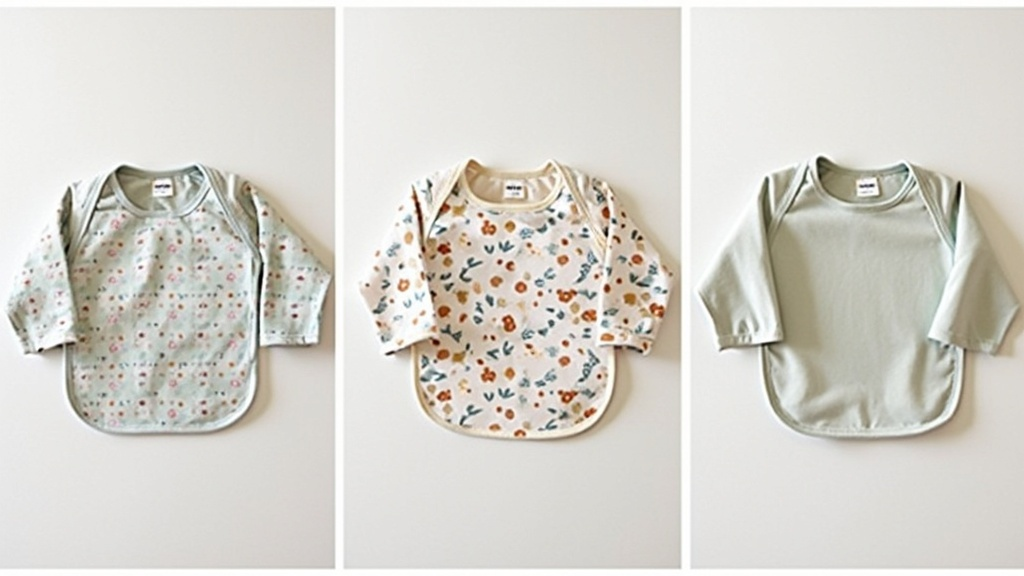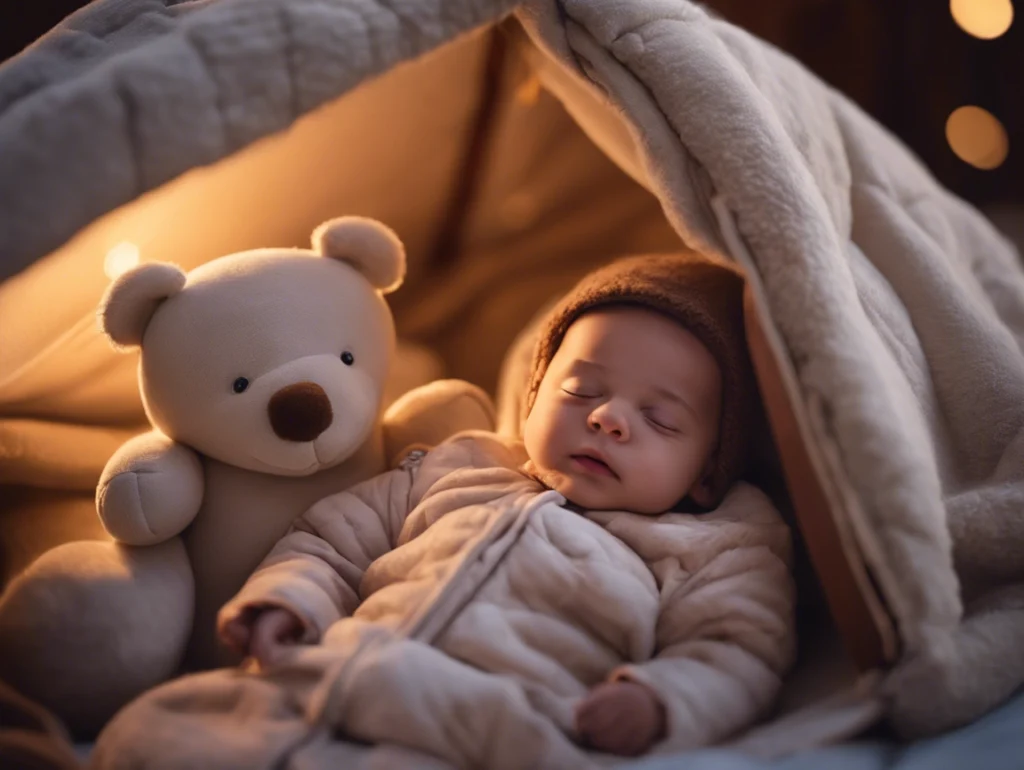When it comes to long sleeve bibs, the fabric makes all the difference. The right material can ensure a bib is effective, durable, and easy to clean, while the wrong one can lead to frustration (and extra laundry). With so many fabric options available, from polyurethane to silicone, how do you decide which one is best for your baby’s needs?
In this guide, we’ll compare popular materials for long sleeve bibs—like PU, recycled polyester with TPU coating, PUL, and silicone—highlighting their strengths, weaknesses, and ideal uses. Whether you’re looking for a bib that’s eco-friendly, waterproof, or durable enough to survive spaghetti night, we’ve got you covered!

Why Fabric Matters for Long Sleeve Bibs
The material of a long sleeve bib impacts:
- Effectiveness: How well it prevents stains, spills, and messes from reaching your baby’s clothes.
- Ease of Cleaning: Whether you can simply wipe it clean or if it requires more extensive washing.
- Comfort: Babies have sensitive skin, so soft, breathable materials are essential for all-day comfort.
- Durability: How well the bib holds up after frequent use and washing.
(Fun Note: A good bib is like a superhero cape—it saves the day, every day!)
Materials Used in Long Sleeve Bibs: A Detailed Comparison
Here’s a breakdown of the most popular materials, their benefits, and drawbacks:
1. PU (Polyurethane)
Description: PU is a high-quality, 100% waterproof fabric often used in baby bibs.
| Benefits | Drawbacks |
|---|---|
| Excellent at keeping clothes clean | Thicker material takes longer to dry |
| Easily wiped down or machine washable | May be less breathable for extended wear |
| Durable and long-lasting | Slightly less eco-friendly compared to other materials |
(Pro Tip: PU bibs are perfect for high-impact messes like soup or finger painting, especially when you need something waterproof.)
2. Recycled Polyester with TPU Coating
Description: This eco-friendly material combines recycled polyester with a TPU (thermoplastic polyurethane) coating for extra durability and water resistance.
| Benefits | Drawbacks |
|---|---|
| Waterproof, stain-resistant, and odor-resistant | Requires careful washing to maintain waterproof layer |
| Certified safe by Oeko-Tex standards | Cannot be ironed |
| Environmentally friendly | Slightly higher cost compared to basic polyester |
(Fun Note: These bibs make you feel good about saving the planet—while saving your baby’s clothes from destruction!)
3. Nylon or Polyester
Description: These lightweight materials are commonly found in budget-friendly bibs.
| Benefits | Drawbacks |
|---|---|
| Lightweight and quick-drying | Less durable than higher-quality fabrics |
| Affordable and widely available | Frequent washing may cause holes or fraying |
| Available in various colors and styles | Offers less protection against heavy spills |
(Pro Tip: Nylon and polyester bibs are great for occasional use or low-mess meals but may not hold up to heavy-duty wear and tear.)
4. PUL (Polyurethane Laminate)
Description: PUL is a laminated fabric often used in cloth diapers and some bibs. While water-resistant, it is not fully waterproof.
| Benefits | Drawbacks |
|---|---|
| Lightweight and flexible | Prone to staining over time |
| Available in many cute designs | Not as effective at containing liquids |
| Machine washable and easy to handle | Requires frequent washing for heavy messes |
(Fun Note: If you love fun patterns, PUL bibs are perfect for adding some personality to mealtime.)
5. Silicone
Description: Silicone bibs are made from soft, food-grade, BPA-free silicone, often featuring a built-in scoop pocket to catch food.
| Benefits | Drawbacks |
|---|---|
| Completely waterproof and durable | May not provide full coverage compared to fabric bibs |
| Easy to clean—just wipe or rinse | Bulkier than fabric options |
| Great for catching food with scoop pockets | Less breathable for long wear |
(Pro Tip: Silicone bibs are a favorite for toddlers learning to self-feed, especially when paired with finger foods.)
Which Fabric Should You Choose?
| Scenario | Best Material |
|---|---|
| Heavy-duty messes | PU or Silicone |
| Eco-conscious parenting | Recycled Polyester with TPU Coating |
| Budget-friendly option | Nylon or Polyester |
| Sensitive baby skin | Bamboo or Cotton (with a waterproof backing) |
| Quick and easy cleaning | Silicone |
(Pro Tip: If you have a particularly messy eater, consider rotating between PU and silicone bibs for maximum protection.)
Care and Maintenance Tips by Material
Proper care extends the lifespan of your bibs and ensures they stay effective.
| Material | Care Instructions |
|---|---|
| PU | Wipe clean after each use; machine washable on a gentle cycle. |
| Recycled Polyester + TPU | Hand wash or gentle machine wash; avoid high heat to protect the coating. |
| Nylon or Polyester | Machine washable, but avoid high heat to prevent shrinking or damage. |
| PUL | Machine washable; air dry to prevent delamination. |
| Silicone | Wipe or rinse clean; dishwasher-safe for easy sanitization. |
FAQs About Long Sleeve Bib Materials
1. Which material is best for waterproofing?
PU and silicone bibs are 100% waterproof, making them ideal for messy meals or water-based activities.
2. Are eco-friendly bib materials as durable?
Yes! Recycled polyester with TPU coating offers excellent durability while being environmentally friendly.
3. Can silicone bibs be used for younger babies?
Silicone bibs work best for older toddlers due to their weight and rigidity. Younger babies may prefer softer fabrics like PU or PUL.
(Check out more tips on baby product safety at HealthyChildren.org.)
4. How do I prevent odors in waterproof bibs?
Rinse bibs immediately after use and ensure they’re fully dry before storing. For stubborn odors, soak them in a vinegar-water solution before washing.
5. Are all materials safe for babies?
Always check for certifications like Oeko-Tex or BPA-free labels to ensure the material is safe and non-toxic for your baby.
Conclusion: The Perfect Bib Material for Every Parent
Choosing the best fabric for your long sleeve bib depends on your priorities—whether you value waterproofing, eco-friendliness, or ease of cleaning. PU and silicone offer excellent mess protection, while recycled polyester with TPU is perfect for sustainability-minded parents. Regardless of your choice, investing in high-quality bibs ensures happier mealtimes and fewer outfit changes!
(Call to Action: Explore our collection of durable, stylish long sleeve bibs at Endearing Baby—because messes happen, but stress doesn’t have to!)

